the UCLA Chicano Studies Research Center,
the Arhoolie Foundation,
and the UCLA Digital Library
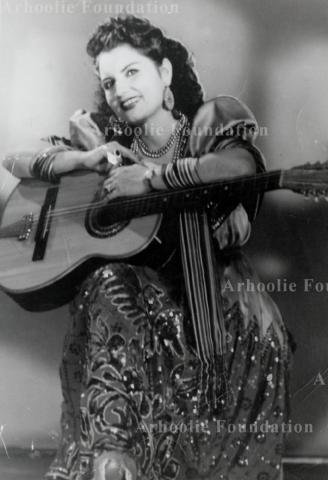 Lydia Mendoza (1916-2007) was one the most enduring and highly honored female artists to hail from the immigrant Mexican-American communities of the Southwest United States. Nicknamed “La Alondra De La Frontera” (The Meadowlark of the Borderlands) and “La Cancionera De Los Pobres” (The Songstress of the Poor), the singer-guitarist enjoyed a career that spanned well over half a century, hundreds of recordings, and thousands of personal appearances.
Lydia Mendoza (1916-2007) was one the most enduring and highly honored female artists to hail from the immigrant Mexican-American communities of the Southwest United States. Nicknamed “La Alondra De La Frontera” (The Meadowlark of the Borderlands) and “La Cancionera De Los Pobres” (The Songstress of the Poor), the singer-guitarist enjoyed a career that spanned well over half a century, hundreds of recordings, and thousands of personal appearances.
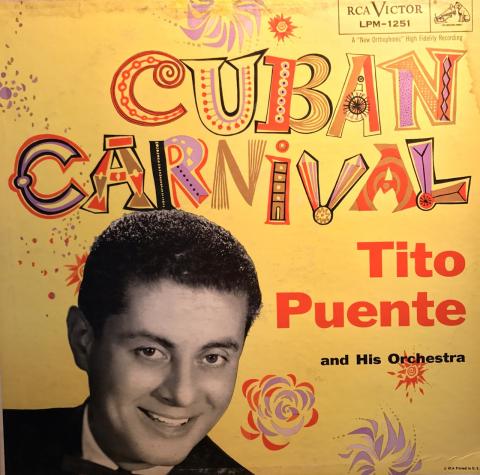 There are only a handful of musicians whose careers have encompassed a half century in the evolution of recorded sound, from 78-rpm discs to digital streaming and downloads. One of them is Tito Puente, the versatile bandleader, percussionist, composer, arranger, and vibraphonist. Born in New York of blue-collar Puerto Rican parents, Puente debuted as bandleader during the thrilling mambo era of the 1950s and was actively touring and recording fifty years later, still a star in the new millennium.
There are only a handful of musicians whose careers have encompassed a half century in the evolution of recorded sound, from 78-rpm discs to digital streaming and downloads. One of them is Tito Puente, the versatile bandleader, percussionist, composer, arranger, and vibraphonist. Born in New York of blue-collar Puerto Rican parents, Puente debuted as bandleader during the thrilling mambo era of the 1950s and was actively touring and recording fifty years later, still a star in the new millennium.
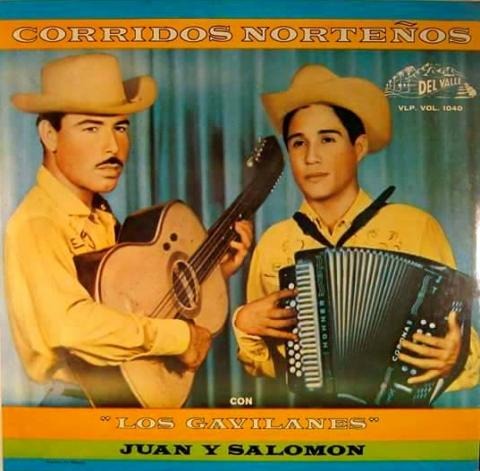 Los Tremendos Gavilanes, the duo of Salomón Prado and Juan Torres, was founded in 1962 at the dawn of the modern age of norteño music. In the 1960s and ’70s, they achieved enormous popularity on both sides of the border and had many imitators, some of whom even usurped their name to try to ride on their coattails. But none could duplicate the magic of these two uniquely compatible musicians and their appealing vocal harmonies.
Los Tremendos Gavilanes, the duo of Salomón Prado and Juan Torres, was founded in 1962 at the dawn of the modern age of norteño music. In the 1960s and ’70s, they achieved enormous popularity on both sides of the border and had many imitators, some of whom even usurped their name to try to ride on their coattails. But none could duplicate the magic of these two uniquely compatible musicians and their appealing vocal harmonies.
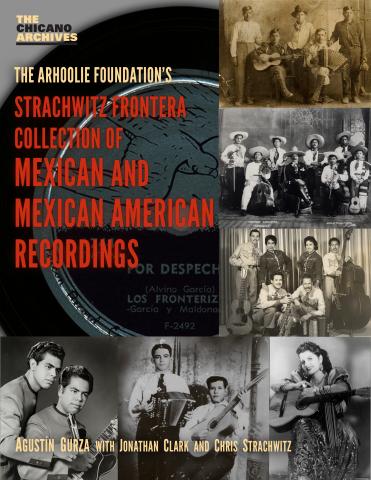 The Arhoolie Foundations’ Strachwitz Frontera Collection of Mexican and Mexican American Recordings, by Agustín Gurza, volume 6 in the Chicano Archives book series from the UCLA Chicano Studies Research Center Press, was released in 2012. The award-winning book is based on an archival project initiated by then CSRC Director Guillermo E. Hernandez: In October 2001, Hernandez started the process to digitally preserve the Arhoolie Foundations’ Strachwitz Frontera Collection, the largest repository of Mexican and Mexican America popular and vernacular recording in existence.
The Arhoolie Foundations’ Strachwitz Frontera Collection of Mexican and Mexican American Recordings, by Agustín Gurza, volume 6 in the Chicano Archives book series from the UCLA Chicano Studies Research Center Press, was released in 2012. The award-winning book is based on an archival project initiated by then CSRC Director Guillermo E. Hernandez: In October 2001, Hernandez started the process to digitally preserve the Arhoolie Foundations’ Strachwitz Frontera Collection, the largest repository of Mexican and Mexican America popular and vernacular recording in existence.
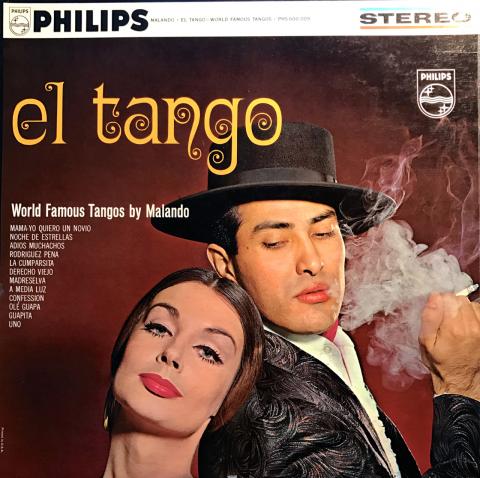 The Argentine tango is one of a handful of song-and-dance styles – along with Spanish flamenco and the Cuban mambo – that emerged from cultural fusions in the Spanish-speaking world and gained global popularity in the 20th century. The tango craze that swept Europe and the U.S. during the first half of the last century may have faded. But the tango as an art form still thrives, in both traditional and contemporary forms.
The Argentine tango is one of a handful of song-and-dance styles – along with Spanish flamenco and the Cuban mambo – that emerged from cultural fusions in the Spanish-speaking world and gained global popularity in the 20th century. The tango craze that swept Europe and the U.S. during the first half of the last century may have faded. But the tango as an art form still thrives, in both traditional and contemporary forms.
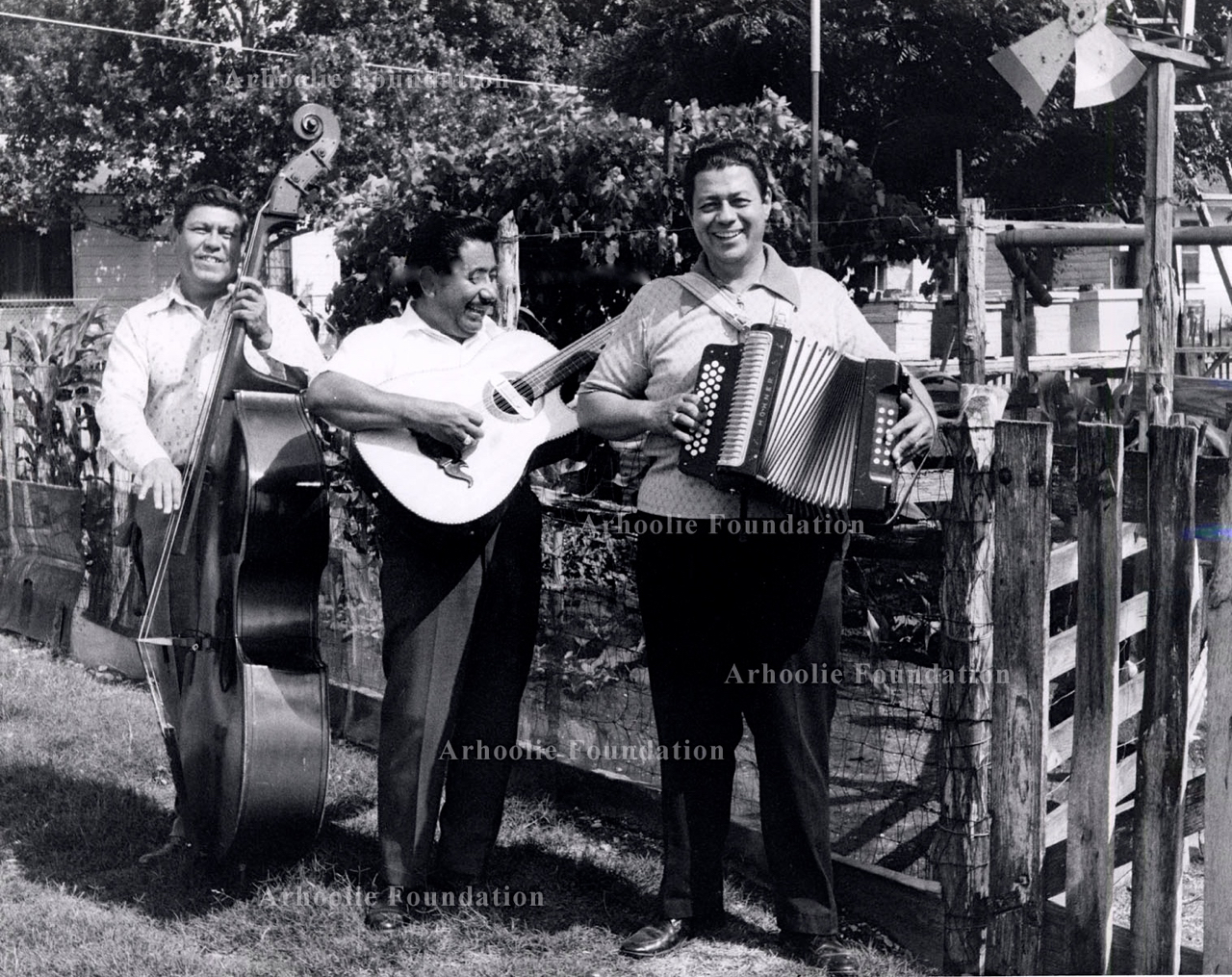 Fred Zimmerle (1931-1998) was born in San Antonio of German and Mexican ancestry, a heritage that embodied the cultural fusion of the border region of South Texas. He became one of the most popular and influential acts in the highly competitive conjunto scene in post-war San Antonio, beloved by fans and respected by peers as a historic figure.
Fred Zimmerle (1931-1998) was born in San Antonio of German and Mexican ancestry, a heritage that embodied the cultural fusion of the border region of South Texas. He became one of the most popular and influential acts in the highly competitive conjunto scene in post-war San Antonio, beloved by fans and respected by peers as a historic figure.
 The Frontera Collection specializes in Mexican American music, especially the early, rural formats of norteño and conjunto groups from the first half of the 20th century. But beginning in the 1970s, new styles produced by young Mexican Americans in large urban centers emerged, fusing traditional and modern genres. In Los Angeles the most influential and critically acclaimed band from that era was Los Lobos del Este de Los Angeles.
The Frontera Collection specializes in Mexican American music, especially the early, rural formats of norteño and conjunto groups from the first half of the 20th century. But beginning in the 1970s, new styles produced by young Mexican Americans in large urban centers emerged, fusing traditional and modern genres. In Los Angeles the most influential and critically acclaimed band from that era was Los Lobos del Este de Los Angeles.
 It’s been almost four decades since the Los Angeles debut of Zoot Suit, the groundbreaking musical about overt racial hostility facing Mexican Americans in Los Angeles during the 1940s. The Luis Valdez play opened at the Mark Taper Forum on July 28, 1978, and a year later had a short run on Broadway. Unless you experienced it at the time, it’s hard to appreciate just how much this cultural milestone meant to Mexican Americans, striving for a more respectable place in American society. The first professionally produced play by and about Mexican-Americans, Zoot Suit shattered cultural and social barriers
It’s been almost four decades since the Los Angeles debut of Zoot Suit, the groundbreaking musical about overt racial hostility facing Mexican Americans in Los Angeles during the 1940s. The Luis Valdez play opened at the Mark Taper Forum on July 28, 1978, and a year later had a short run on Broadway. Unless you experienced it at the time, it’s hard to appreciate just how much this cultural milestone meant to Mexican Americans, striving for a more respectable place in American society. The first professionally produced play by and about Mexican-Americans, Zoot Suit shattered cultural and social barriers
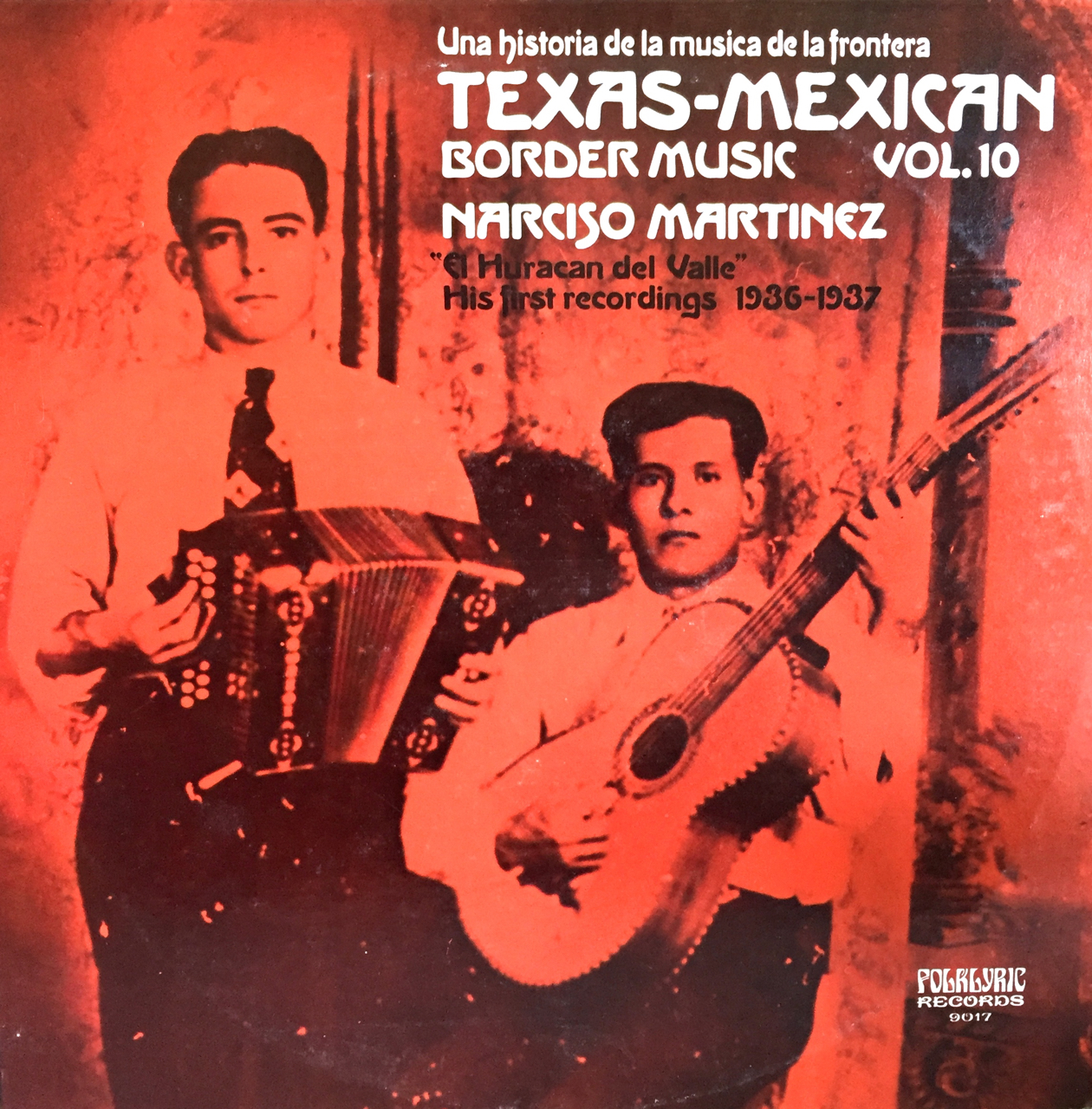 Santiago Almeida was an exceptional bajo sexto player who gained a historic place in the pantheon of Mexican-American music as the pioneering partner of famed accordionist Narciso Martinez. Together, the duo would shape the style we know today as conjunto music, with the accordion and 12-string guitar as its instrumental core.
Santiago Almeida was an exceptional bajo sexto player who gained a historic place in the pantheon of Mexican-American music as the pioneering partner of famed accordionist Narciso Martinez. Together, the duo would shape the style we know today as conjunto music, with the accordion and 12-string guitar as its instrumental core.
In the late 1970s, in between journalism jobs, I worked in the music industry, on the selling, not the producing, side. With absolutely no direct experience in the market, I took a job as Latin-music buyer for Pickwick International, a major record  distributer on a national level. With a gargantuan warehouse in the San Fernando Valley, the company operated its own chain of record stores, Musicland, and supplied hundreds of record departments in national retail chains, including Sears, Woolworths, Montgomery Ward, and Kmart.
distributer on a national level. With a gargantuan warehouse in the San Fernando Valley, the company operated its own chain of record stores, Musicland, and supplied hundreds of record departments in national retail chains, including Sears, Woolworths, Montgomery Ward, and Kmart.
 Los Cadetes de Linares was a popular norteño duo composed in its prime by Homero Guerrero and Lupe Tijerina, both from the town of Linares, Nuevo Leon, south east of Monterrey, Mexico. They were particularly well known for their popular corridos, starting with their first single, “Los Dos Amigos” (The Two Friends), written by Tijerina. Their career together lasted a short eight years, until Guerrero’s untimely death. Yet, they left a lasting legacy through scores of recordings as well as appearances in films that carried the titles of their best-known ballads of outlaw bravado and tragedy, including “Las Tres Tumbas” (The Three Graves), “Cazador de Asesinos” (Hunter of Assassins) and “Pistoleros Famosos” (Famous Gunslingers).
Los Cadetes de Linares was a popular norteño duo composed in its prime by Homero Guerrero and Lupe Tijerina, both from the town of Linares, Nuevo Leon, south east of Monterrey, Mexico. They were particularly well known for their popular corridos, starting with their first single, “Los Dos Amigos” (The Two Friends), written by Tijerina. Their career together lasted a short eight years, until Guerrero’s untimely death. Yet, they left a lasting legacy through scores of recordings as well as appearances in films that carried the titles of their best-known ballads of outlaw bravado and tragedy, including “Las Tres Tumbas” (The Three Graves), “Cazador de Asesinos” (Hunter of Assassins) and “Pistoleros Famosos” (Famous Gunslingers).
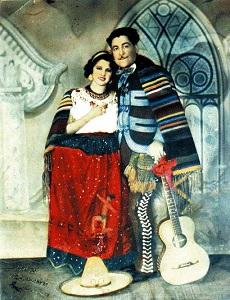 During the Great Depression of the 1930s, Los Madrugadores (The Early Risers) became the most popular group in Mexican-American music in the U.S. The folk ensemble was started by Pedro J. González, a controversial and charismatic personality considered the founder of Spanish-language radio in Los Angeles in the late 1920s. Its name – which comes from “madrugada,” the Spanish word for dawn – refers as much to the band as to its blue-collar audience, those “early risers” who listened to them perform live on the radio from 4 to 6 a.m. as they got ready to go to work. For a group that was marginalized, disdained, and persecuted during the Depression, the moniker also conveyed a certain sense of pride because it carried the connotation of being “hard workers” and “go-getters.”
During the Great Depression of the 1930s, Los Madrugadores (The Early Risers) became the most popular group in Mexican-American music in the U.S. The folk ensemble was started by Pedro J. González, a controversial and charismatic personality considered the founder of Spanish-language radio in Los Angeles in the late 1920s. Its name – which comes from “madrugada,” the Spanish word for dawn – refers as much to the band as to its blue-collar audience, those “early risers” who listened to them perform live on the radio from 4 to 6 a.m. as they got ready to go to work. For a group that was marginalized, disdained, and persecuted during the Depression, the moniker also conveyed a certain sense of pride because it carried the connotation of being “hard workers” and “go-getters.”
 Almost every country has a set of songs that make up its musical DNA. Songs that children learn almost from the time they can speak, such as “Home On the Range,” “Oh, Susana,” and “This Land Is Your Land” in the United States.
Almost every country has a set of songs that make up its musical DNA. Songs that children learn almost from the time they can speak, such as “Home On the Range,” “Oh, Susana,” and “This Land Is Your Land” in the United States.
In Mexico, one such iconic tune is the ranchera classic “Allá en el Rancho Grande.” Like other songs emblematic of a national culture, “Rancho Grande” has a melody that is instantly recognizable and a lyric that seems to spring from the country’s collective memory, though we may not understand exactly what the words mean.
 It is one of the most recognizable beats in the history of popular dance music: One, two, cha-cha-cha.
It is one of the most recognizable beats in the history of popular dance music: One, two, cha-cha-cha.
For a time in the 1950s, this Afro-Cuban rhythm also became a dance craze that swept the western world, from Paris to Caracas, from New York to Mexico City. The cha-cha-cha became one of the staples of ballroom dancing, along with the mambo and the rumba. Simultaneously, the light and cheerful beat of this new dance rhythm also seeped into the DNA of early rock ‘n’ roll.
 Memo Salamanca was an important composer, arranger, and bandleader who played a prominent role in the popularity of Afro-Cuban dance music that swept Mexico in the 1950s. Salamanca was associated with the leading Cuban artists of the day who had moved to the Mexican capital to ride the mambo craze, including bandleader Perez Prado and venerated Cuban singer Beny Moré.
Memo Salamanca was an important composer, arranger, and bandleader who played a prominent role in the popularity of Afro-Cuban dance music that swept Mexico in the 1950s. Salamanca was associated with the leading Cuban artists of the day who had moved to the Mexican capital to ride the mambo craze, including bandleader Perez Prado and venerated Cuban singer Beny Moré.
 The death of Mexican singer and songwriter Juan Gabriel made headlines around the world this week. He was one of the most important and beloved pop music figures in Mexico from the last half of the 20th century. His career parallels that of a handful of superstar peers, including Vicente Fernandez and Los Tigres del Norte, who ascended in the 1970s and whose popularity continued into the new millennium.
The death of Mexican singer and songwriter Juan Gabriel made headlines around the world this week. He was one of the most important and beloved pop music figures in Mexico from the last half of the 20th century. His career parallels that of a handful of superstar peers, including Vicente Fernandez and Los Tigres del Norte, who ascended in the 1970s and whose popularity continued into the new millennium.
Flor Silvestre is a Mexican singer, actress, and equestrienne whose career on stage, screen, and television spans more than seven decades. She is best known to international audiences as part of the rodeo-performing dynasty led by her husband, fellow singer and actor Antonio Aguilar.
Acclaimed for her sensual beauty on screen and her lovely, natural vocals, Silvestre became a sought-after film star during the so-called Golden Age of Mexican cinema in the 1940s. She shared the marquee with top artists of the day, such as María Felix and Miguel Aceves Mejía, and she won fans with her performance of popular rancheras in her films. From the beginning, Silvestre launched a concurrent recording career, making a series of successful albums for three major labels: Columbia Records, RCA Victor, and especially Musart, the Mexican independent.
 There are famous country singers, like Johnny Cash or Loretta Lynn, whose songs reflect the struggles and hardships they experienced in real life. More than celebrities, they become folk heroes, because people sense authenticity in their artistry. The same is true for singer Lucha Reyes, a pioneer in Mexican ranchera music. Known for her bravado, her forceful voice and her hard-drinking ways, Reyes became a popular sensation in the 1930s as a solo singer, often backed by the legendary Mariachi Vargas de Tecalitlán.
There are famous country singers, like Johnny Cash or Loretta Lynn, whose songs reflect the struggles and hardships they experienced in real life. More than celebrities, they become folk heroes, because people sense authenticity in their artistry. The same is true for singer Lucha Reyes, a pioneer in Mexican ranchera music. Known for her bravado, her forceful voice and her hard-drinking ways, Reyes became a popular sensation in the 1930s as a solo singer, often backed by the legendary Mariachi Vargas de Tecalitlán.
 When I was in college, my father would make occasional trips from San Jose to Los Angeles to see the new mariachi at La Fonda, a restaurant on Wilshire Boulevard His visits were more like musical pilgrimages. Dr. Gurza would say there was no place to hear a good mariachi in the Bay Area. So, whenever he’d drive south, ostensibly to visit a friend from our hometown of Torreon, he’d always make a beeline for La Fonda first. That was an 8-hour drive in those days, on the old 101 Highway. But Dad was never too tired to take in a set or two by Los Camperos de Nati Cano.
When I was in college, my father would make occasional trips from San Jose to Los Angeles to see the new mariachi at La Fonda, a restaurant on Wilshire Boulevard His visits were more like musical pilgrimages. Dr. Gurza would say there was no place to hear a good mariachi in the Bay Area. So, whenever he’d drive south, ostensibly to visit a friend from our hometown of Torreon, he’d always make a beeline for La Fonda first. That was an 8-hour drive in those days, on the old 101 Highway. But Dad was never too tired to take in a set or two by Los Camperos de Nati Cano.
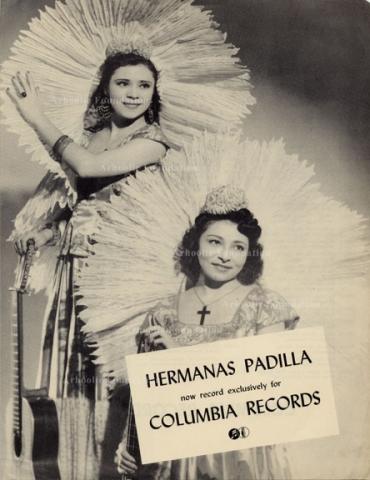 Las Hermanas Padilla, sometimes billed as the Andrew Sisters of Mexican music due to their pitch-perfect harmonies, was one of the most popular and prolific Mexican vocal duets of the 1930s and ’40s. Based in Los Angeles, the Padilla sisters, Margarita and María, set a standard for their style of singing boleros and rancheras, becoming among the first internationally successful recording acts to emerge from the Mexican American music scene in Southern California.
Las Hermanas Padilla, sometimes billed as the Andrew Sisters of Mexican music due to their pitch-perfect harmonies, was one of the most popular and prolific Mexican vocal duets of the 1930s and ’40s. Based in Los Angeles, the Padilla sisters, Margarita and María, set a standard for their style of singing boleros and rancheras, becoming among the first internationally successful recording acts to emerge from the Mexican American music scene in Southern California.
Stay informed on our latest news!